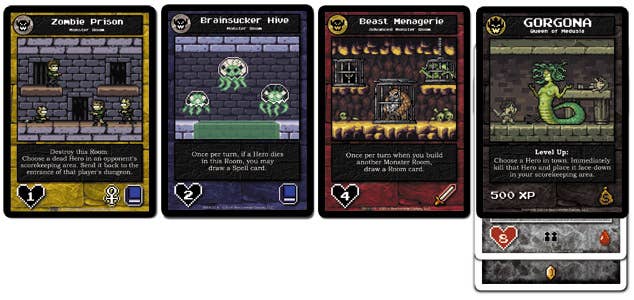Boss Monster Captures the Spirit of 8-Bit Platforming in Card Game Format
Brotherwise Games' love letter to '80s classics stands as a great (and affordable) way to break into the wide world of non-video gaming.
This article first appeared on USgamer, a partner publication of VG247. Some content, such as this article, has been migrated to VG247 for posterity after USgamer's closure - but it has not been edited or further vetted by the VG247 team.
If you're looking to hone your video game-analyzing skills—admittedly, a proposition with limited applications—I can't recommend getting into card and board games enough.
With no CPU present to automate everything, and no imposed narrative to serve as a distraction, tabletop gaming forces you to focus on pure systems, mechanics, and cycles—and how these interlocking elements deal with the randomness of dice rolls or card draws. Unfortunately, gaming outside the confines of a TV screen or monitor requires the right kind of play space, access to other human beings, and a prescribed (and often lengthy) time commitment, which can be a tall order for those of us living busy adult lives. This recent holiday break gave me the chance to dive into my pile of mostly-unplayed tabletop games, though, and the one that looked the most appealing preyed on my weakness for retro games: Brotherwise Games' Boss Monster, what with its packaging designed to closely resemble the first wave of "black box" releases for the NES.
As indicated by the title, Boss Monster throws you into the role of an end-of-game baddie that closely resembles an 8-bit supervillain—like its variant of Super Mario Bros. 2's Wart on the box. As you play, you progressively build a harrowing, side-scrolling dungeon (that flows left-to-right, obviously) for the purpose of luring unwitting heroes to their doom. If said heroes make it to your lair, they inflict damage on your terrifying form, but if they kick the bucket before this point, you claim their soul. Boss Monster's overall goal boils down to capturing ten of these souls before anyone else can, and taking no more than four hits from heroes who manage to sneak past your many traps and monsters with their HP intact. It's an incredibly easy game to learn, but one that still provides plenty of room for strategizing and important, game-altering decisions at every turn.
Building an effective dungeon in Boss Monster is all about taking advantage of the current situation. Every turn brings new heroes into "town," and knowing which to lure in and which to keep away stands as the key to success. Each room you build features one of four icons in the lower-right corner—each corresponding to a particular class of hero—and the local population of adventurers is drawn to whichever dungeon offers the most of their particular symbol. Since each room (or card) inflicts a specific amount of damage to heroes as they move towards your lair, the early stages of play are usually spent keeping them away until your dungeon has enough power to kill them outright.
Your rooms aren't simply damage-dealers, though: A good portion of them offer special effects and bonuses under the right conditions. A room that inflicts zero damage, for instance, might send players back to the previous room, which essentially doubles the damage performed by that particular card. Some rooms grant bonuses to adjacent rooms, some can only be built over rooms with matching icons, and others provide a bonus (like a free card) if a hero dies there, specifically. Needless to say, adding another room to your dungeon can often be a painful and protracted decision.

Spell cards—one of the most limited resources in the game—offer some incredibly powerful effects designed to either completely screw over your opponent, or save you from harm. If a hero with too much HP finds their way to your dungeon, you can use a spell card to sacrifice a room to kill them outright, or send them back to town. If you spot a few heroes that seem likely to be lured to your dungeon on the next turn, a certain spell card prevents your opponents from building any rooms, making these adventurers' deaths at your hands a guarantee. These cards can be a bit overpowered, but they make it so one person isn't likely to have an overwhelming advantage for too long—I had a few games where playing a spell card at the exact right moment saved me from utter defeat, or at least gave me some hope for success.
If you've found the world of card and board games to be a little too intimidating, Boss Monster is a great place to start. With its use of classic video game terminology and graphics, it provides a friendly degree of familiarity, and setup doesn't take long at all. And since the game scales with the amount of players involved, you can play with just one other person comfortably—I played several games with my girlfriend, and they usually didn't take long than 15 minutes to conclude. Not to mention the fact that Boss Monster's $20 retail price offers a much less intimidating cost of admission—most of the popular tabletop games typically cost as much (or more) than a new console release. Granted, the 8-bit theme might be little more than window dressing, but it works to add a lot of flavor to a card game that's very solid to begin with. It's not quite as solid as the big German behemoths like Settlers of Catan or Carcassonne, but if you're looking to expand your horizons, Boss Monster makes for the perfect introduction to a brand of gaming completely removed from polygonal spectacle.

